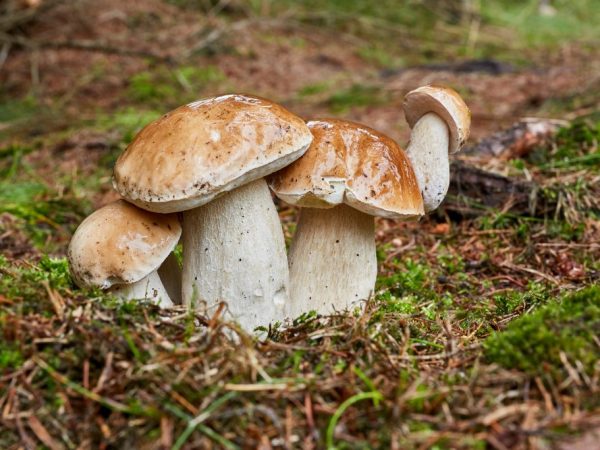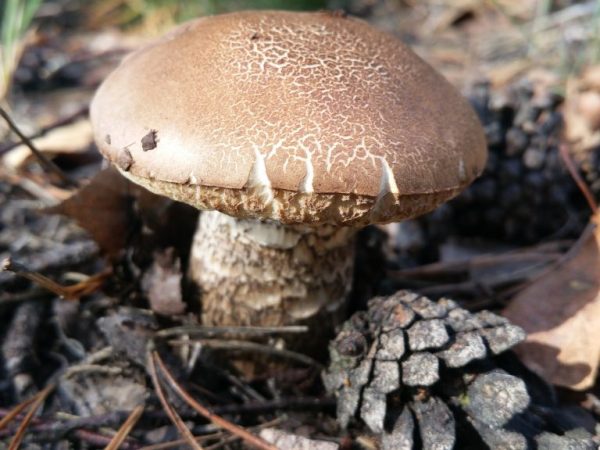What doubles does the porcini have?
Sometimes, instead of the desired, everyone's favorite mushrooms, poisonous varieties, which include the counterparts of the "king of the forests" - the porcini mushroom, fall into the basket.

White mushroom doubles
General description of dangerous twins
For many edible mushrooms, their poisonous or conditionally edible counterparts are known. The similarities can be strong or superficial. So, the porcini mushroom and some of its counterparts are absolutely identical in their external features. Putting a doppelganger of a porcini mushroom in a basket is easy to get poisoned and, at best, go to a hospital bed. A mistake in choosing can be fatal and lead to a sad outcome.
Even mushroom pickers with many years of experience sometimes at first glance cannot distinguish a dangerous double of a porcini mushroom from a real and noble specimen. Edible noble Boletus has its own characteristics and differs both in appearance and in taste.
The main distinguishing feature of edibles from poisonous ones is their chemical composition, which includes toxins.
External signs are deceiving: for example, the fly agaric loses its white spots on the cap after a good shower and looks like a red russula. False honey changes the color of the cap with age and becomes even more similar to the real one.
According to the action of toxins, insidious false mushrooms are divided into several categories according to the types of poisoning caused:
- food intoxication;
- damage to the nervous system;
- poisoning with a fatal outcome.
Before going into the forest, you should understand how the porcini mushroom differs from its dangerous counterparts. One of the external signs that a person pays attention to is the structure of the hymenophore. Unfortunately, in all representatives of sibling species, it is similar in structure to that of the edible original and is spongy. Therefore, it is worth paying attention to the change in its color. You also need to be careful when studying the color of the cut (break) of the pulp. True white never changes color at a break, therefore, before putting the fruit body in the basket, it is better to break off a small piece from it and see what happens.
Views
The noblest mushroom, the king of the forest kingdom, has several brothers that are dangerous to human life. These include:
- gall mushroom;
- boletus is beautiful;
- sick satanic;
- boletus le Gal;
- speckled oak tree.
Gall mushroom
The second name of this species is the bitter (Tylopilus felleus). He deserved it quite rightly, precisely because of his bitter taste. The gall fungus belongs to the class Agaricomycetes, the Boletovye family, the Tilopil genus. Refers to inedible.

Gorchak has a bitter taste
Its description:
- the shape of the cap in the form of a hemisphere;
- cap color from yellow to brown;
- diameter - 4-15 cm;
- the pulp is fibrous, white, thick, soft, turns red on the cut;
- there is no aroma;
- hymenophore spongy;
- pores are angular or rounded;
- spore powder pink;
- the leg is cylindrical;
- height - 3-14 cm;
- thickness - 3 cm.
A characteristic feature of bitterness and a difference from the white "brother" is a bitter taste and a change in color on the cut.It turns from white to red.
Boletus is beautiful
Boletus pulcherrimus, or beautiful boletus, is another poisonous species. It has an external resemblance to the common boletus, but changes color on the cut (turns blue) and is extremely toxic.
Description:
- the cap is large, hemispherical (up to 25 cm);
- velvety and dry to the touch;
- skin color is reddish brown;
- the pulp is dense, yellowish;
- tubular hymenophore;
- the pores are red;
- spores brown, spindle-shaped;
- the leg is thick (up to 12 cm), clavate or cylindrical;
- grows in height up to 15 cm;
- the taste is sweetish at first, then very bitter, there is no smell.
A characteristic feature is the presence of a fine mesh on the leg. Under the cap there are tubes, serrated, with a yellowish tinge and up to 15 cm long. When pressed, they turn blue.
Bolette satanic
Belongs to the biological group of boletus. Forms mycorrhiza with oaks, lindens and birches. This double is dangerous to health, eaten 30 g of the pulp of the satanic mushroom causes severe symptoms of poisoning. Its description:
- the cap is large, sometimes giant (30-40 cm);
- cushion shape;
- the surface is smooth;
- the color of the cap is olive or brown;
- the skin is dense;
- from below the cap is spongy (i.e., the hymenophore is spongy);
- pore color pink;
- the leg is narrowed downwards, cylindrical;
- height - up to 13 cm.
Irina Selyutina (Biologist):
The satanic mushroom is often called "false white mushroom" in various sources. They began to do this not so long ago. However, confusing the porcini mushroom and the satanic one is possible only with a cursory glance from afar. This is especially true for novice mushroom pickers who have memorized the "face and profile" of the porcini mushroom, and everything else has not been memorized yet. Therefore, you need to carefully look at the color of the fruiting body. The satanic mushroom is characterized by many red colors and, above all, its hymenophore is red. There are also many red tones in the coloration of the leg.
By the way. The specific epithet "satanas" for the satanic mushroom (Rubroboletus satanas) was proposed by the German mycologist Harald Otmar Lenz (1798-1870) after he himself was poisoned by this mushroom.
The satanic mushroom is characterized by a blue cut on contact with air, which gradually turns red. This is due to the oxidation process of the poison with oxygen.
Speckled oak

Dubovik is an edible species.
Boletus erythropus is an edible sibling. It can be used in food, soups, or other dishes. This forest organism has the following description:
- cap size - up to 20 cm in diameter;
- it is dry and velvety to the touch;
- cushion shape;
- skin color is red-brown;
- olive spore powder;
- the pores are red or orange, but the tubes are greenish-yellow (in mature ones);
- leg 10 cm high;
- tuberous stem shape.
A characteristic feature is the darkening of the light edge of the cap after pressing on it and small reddish scales on the stem of the stem. A distinctive feature from the original is the blue on the cut of the pulp.
Borovik le Gal
Another poisonous mushroom, similar to white, is le Gal boletus (Boletus legaliae), or legal boletus. It is characterized by the following description:
- convex cap, up to 15 cm;
- the surface is smooth;
- pink-orange color;
- the pulp is pale, yellowish;
- the aroma is pleasant;
- tubular hymenophore;
- spores of olive color;
- the leg is thick, up to 5-6 cm in diameter;
- leg height - up to 17 cm.
Irina Selyutina (Biologist):
Boletus licit is quite widespread in the wild nature of Europe, where it inhabits mainly deciduous forests. As a mycorrhizal forming agent, it enters into symbiosis with oak, beech, hornbeam. Prefers alkaline soils, i.e. soils for which pH> 7 (where pH is soil acidity).
A feature is a small reddish mesh on the leg and the flesh that turns blue on the cut.
Contraindications and harm
A mistake made while harvesting a forest crop can be fatal.A cruel joke will be played by inedible doubles who disguise themselves well as their noble brothers.
One small piece of the fruiting body of a poisonous organism can cause a lot of trouble. At the first sign of poisoning, it is necessary to rinse the stomach and then go to the hospital for help. Signs of poisoning include dizziness, nausea, vomiting, limb weakness, diarrhea, and fever.
Often, the victims have hallucinations. Toxic substances of sibling species act on the nervous system, infect blood vessels and cause convulsive reflexes along with hallucinations.
Application
Medicines that we use are prepared not only from edible, but also from poisonous or conditionally edible mushrooms.
Inedible white twins are successfully used for bactericidal preparations and ointments for frostbite. They contain substances that help fight staphylococcus and cancerous tumors.
The boletus extract is used to treat typhoid, paratyphoid fever and purulent skin lesions.
White mushroom doubles contain a large amount of psilocybin and alkaloids in their pulp. These substances actively affect the brain of a mentally ill person and normalize its activity.
Conclusion
When collecting mushrooms, you should not take everything that comes across on the way, pluck unfamiliar organisms out of idle curiosity: this is fraught with poisoning. Some doubles are so dangerous that they are fatal.



